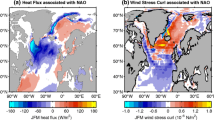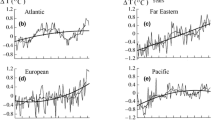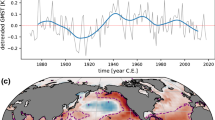Abstract
The Atlantic Multidecadal Oscillation (AMO) is a pronounced signal of climate variability in the North Atlantic sea-surface temperature field. In this paper, we propose an explanation of the physical processes responsible for the timescale and the spatial pattern of the AMO. Our approach involves the analysis of solutions of a hierarchy of models. In the lowest member of the model hierarchy, which is an ocean-only model for flow in an idealized basin, the variability shows up as a multidecadal oscillatory mode which is able to destabilize the mean thermohaline circulation. In the highest member of the model hierarchy, which is the Geophysical Fluid Dynamics Laboratory R30 climate model, multidecadal variability is found as a dominant statistical mode of variability. The connection between both results is established by tracing the spatial and temporal expression of the multidecadal mode through the model hierarchy while monitoring changes in specific quantities (mechanistic indicators) associated with its physics. The proposed explanation of the properties of the AMO is eventually based on the changes in the spatial patterns of variability through the model hierarchy.












Similar content being viewed by others
References
Bjerknes J (1964) Atlantic air–sea interaction. Adv Geophys 10:1–82
Chen F, Ghil M (1995) Interdecadal variability of the thermohaline circulation and high-latitude surface fluxes. J Phys Oceanogr 22:161–167
Chen F, Ghil M (1996) Interdecadal variability in a hybrid coupled ocean–atmosphere model. J Phys Oceanogr 26:1561–1578
Colin de Verdière A, Huck T (1999) Baroclinic instability: an oceanic wavemaker for interdecadal variability. J Phys Oceanogr 29:893–910
Delworth TL, Greatbatch RG (2000) Multidecadal thermohaline circulation variability driven by atmospheric surface flux forcing. J Climate 13:1481–1495
Delworth, TL, Mann ME (2000) Observed and simulated multidecadal variability in the Northern Hemisphere. Clim Dyn 16:661–676
Delworth TL, Manabe S, Stouffer RJ (1993) Interdecadal variations of the thermohaline circulation in a coupled ocean–atmosphere model. J Climate 6:1993–2011
Delworth TL, Stouffer RJ, Dixon KW, Spelman MJ, Knutson TR, Broccoli AJ, Kushner PJ, Wetherald RT (2002) Review of simulations of climate variability and change with the GFDL R30 coupled climate model. Clim Dyn 19:555–574
Dong B, Sutton RT (2005) Mechanism of interdecadal thermohaline circulation variability in a coupled ocean–atmosphere GCM. J Climate 18:1117–1135
Enfield DB, Mestas-Nuñe AM, Trimble P (2001) The Atlantic multidecadal oscillation and its relation to rainfall and river flows in the continental US. Geophys Res Lett 28:2077–2080
Folland CK, Parker DE, Kates FE (1984) Worldwide marine temperature fluctuations. Nature 310:670–673
Gray WM, Sheaffer JD, Landsea CW (1997) Climate trends associated with multidecadal variability of Atlantic hurricane activity. In: Diaz H, Pulwarthy D (eds) Hurricanes: climate and socioeconomic impacts. Springer, Berlin Heidelberg New York, pp 15–53
Greatbatch RJ, Petersen KA (1996) Interdecadal variability and oceanic thermohaline adjustment. J Geophys Res 101:20467–20482
Greatbatch RJ, Zhang S (1995) An interdecadal oscillation in an idealized ocean basin forced by constant heat flux. J Climate 8:82–91
Griffies SM, Tziperman E (1995) A linear thermohaline oscillator driven by stochastic atmospheric forcing. J Climate 8:2440–2453
Hasselmann K (1976) Stochastic climate models. I: theory. Tellus 28:473–485
Huck T, Vallis G (2001) Linear stability analysis of the three-dimensional thermally-driven ocean circulation: application to interdecadal oscillations. Tellus 53A:526–545
Huck T, Colin de Verdière A, Weaver AJ (1999) Interdecadal variability of the thermohaline circulation in box-ocean models forced by fixed surface fluxes. J Phys Oceanogr 29:865–892
Huck T, Vallis G, Colin de Verdière, A (2001) On the robustness of interdecadal modes of the thermohaline circulation. J Climate 14:940–963
Jin F-F (1997) A theory of interdecadal climate variability of the North Pacific ocean–atmosphere system. J Climate 10:1821–1835
Kerr RA (2000) A North Atlantic climate pacemaker for the centuries. Science 288:1984–1986
Kravtsov S, Ghil M (2004) Interdecadal variability in a hybrid coupled ocean–atmosphere–sea ice model. J Phys Oceanogr 34:1756–1775
Kushnir Y (1994) Interdecadal variations in North Atlantic sea surface temperature and associated atmospheric conditions. J Phys Oceanogr 7:141–157
Latif M, Roeckner E, Botzet M, Esch M, Haak H, Hagemaann S, Jungclaus J, Legutke S, Marsland S, Mikolajewicz, Mitchell J (2004) Reconstructing, monitoring and predicting multidecadal-scale changes in the North Atlantic thermohaline circulation with sea-surface temperature. J Climate 17:1605–1614
Moron V, Vautard R, Ghil M (1998) Trends, interdecadal and interannual oscillations in global sea-surface temperature. Clim Dyn 14:545–569
Neelin JD, Battisti DS, Hirst AC, Jin F-F, Wakata Y, Yamagata T, Zebiak SE (1998) ENSO theory. J Geophys Res 103:14261–14290
Plaut G, Vautard R (1994) Spells of low-frequency oscillations and weather regimes in the northern hemisphere. J Atmos Sci 51:210–236
Preisendorfer RW (1988) Principal component analysis in meteorology and oceanography. Elsevier, Amsterdam
Roulston M, Neelin JD (2000) The response of an ENSO model to climate noise, weather noise and intraseasonal forcing. Geophys Res Lett 27:3723–3726
Saravanan R, McWilliams J (1998) Advective ocean–atmosphere interaction: an analytical stochastic model with implications for decadal variability. J Climate 11:165–188
Schlesinger ME, Ramankutty N (1994) An oscillation in the global climate system of period 65–70 years. Nature 367:723–726
Sutton RT, Hodson DLR (2005) Atlantic Ocean forcing of North American and European summer climate. Science 309:115–118
Te Raa LA, Dijkstra HA (2002) Instability of the thermohaline ocean circulation on interdecadal time scales. J Phys Oceanogr 32:138–160
Te Raa LA, Dijkstra HA (2003a) Modes of internal thermohaline variability in a single-hemispheric ocean basin. J Mar Res 61:491–516
Te Raa LA, Dijkstra HA (2003b) Sensitivity of North Atlantic multidecadal variability to freshwater flux forcing. J Climate 32:138–160
Te Raa LA, Gerrits J, Dijkstra HA (2004) Identification of the mechanism of interdecadal variability in the North Atlantic Ocean. J Phys Oceanogr 34:2792–2807
Tourre YM, Rajagopalan, Kushnir Y (1999) Dominant patterns of climate variability in the Atlantic Ocean during the last 136 years. J Climate 12:2285–2299
Venegas S, Mysak L (2000) Is there a dominant timescale of natural climate variability in the Arctic? J Climate 13:3412–3434
This work was supported by the Netherlands Organization for Scientific Research (NWO) under a PIONIER grant to H.D. and NSF grant OCE-0425484. The authors thank Mathijs Schouten for his help with the M-SSA software and Tom Delworth (GFDL) for providing the GFDL-R30 data.
Author information
Authors and Affiliations
Corresponding author
Additional information
Responsible Editor: Tal Ezer
Rights and permissions
About this article
Cite this article
Dijkstra, H.A., te Raa, L., Schmeits, M. et al. On the physics of the Atlantic Multidecadal Oscillation. Ocean Dynamics 56, 36–50 (2006). https://doi.org/10.1007/s10236-005-0043-0
Received:
Accepted:
Published:
Issue Date:
DOI: https://doi.org/10.1007/s10236-005-0043-0




